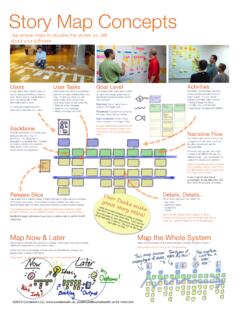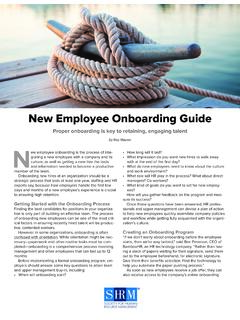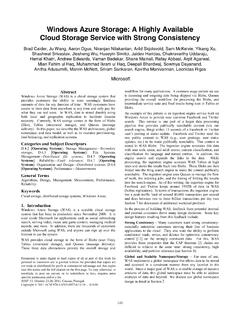Transcription of Unity - Tutorialspoint
1 Unity i Unity i About the Tutorial Unity is a cross-platform game engine initially released by Unity Technologies, in 2005. The focus of Unity lies in the development of both 2D and 3D games and interactive content. Unity now supports over 20 different target platforms for deploying, while its most popular platforms are the PC, Android and iOS systems. Audience This tutorial is designed for those who find the world of gaming exciting and creative. The tutorials will help the readers who aspire to learn game-making.
2 Prerequisites It is important to have access to machine that meets Unity s minimum requirements. A prerequisite knowledge of basic C# is required for full understanding of this series. Copyright & Disclaimer Copyright 2018 by Tutorials Point (I) Pvt. Ltd. All the content and graphics published in this e-book are the property of Tutorials Point (I) Pvt. Ltd. The user of this e-book is prohibited to reuse, retain, copy, distribute or republish any contents or a part of contents of this e-book in any manner without written consent of the publisher. We strive to update the contents of our website and tutorials as timely and as precisely as possible, however, the contents may contain inaccuracies or errors.
3 Tutorials Point (I) Pvt. Ltd. provides no guarantee regarding the accuracy, timeliness or completeness of our website or its contents including this tutorial. If you discover any errors on our website or in this tutorial, please notify us at Unity ii Table of Contents About the Tutorial .. i Audience .. i Prerequisites .. i Copyright & Disclaimer .. i Table of Contents .. ii 1. Unity Introduction .. 1 2. Unity Installation and Setting Up .. 2 Creating your First Project .. 4 Knowing the Engine .. 6 How Unity Works? .. 8 3. Unity Creating Sprites.
4 12 4. Unity Modifying Sprites .. 16 5. Unity Transforms and Object Parenting .. 20 What is Object Parenting? .. 20 6. Unity Internal Assets .. 23 7. Unity Saving and Loading Scenes .. 27 Your First Script .. 27 8. Unity Basic Movement Scripting .. 29 9. Unity Understanding Collisions .. 32 10. Unity Rigidbodies and Physics .. 35 11. Unity Custom Collision Boundaries .. 38 12. Unity Understanding Prefabs and Instantiation .. 40 13. Unity GameObject Destruction .. 43 14. Unity Coroutines .. 46 15. Unity The Console .. 49 16. Unity Introduction to Audio .. 51 Unity iii The Audio Components.
5 51 Playing a Sound .. 53 17. Unity Starting with UI .. 58 Screen Space - Overlay .. 61 Screen Space - Camera .. 62 World Space .. 62 18. Unity The Button .. 63 19. Unity Text Element .. 67 20. Unity The Slider .. 70 21. Unity Materials and Shaders .. 73 What is a material? .. 73 What is a shader? .. 74 22. Unity The Particle System .. 75 23. Unity Using the Asset Store .. 78 Unity 1 Unity is a cross-platform game engine initially released by Unity Technologies, in 2005. The focus of Unity lies in the development of both 2D and 3D games and interactive content.
6 Unity now supports over 20 different target platforms for deploying, while its most popular platforms are the PC, Android and iOS systems. Unity features a complete toolkit for designing and building games , including interfaces for graphics, audio, and level-building tools, requiring minimal use of external programs to work on projects. In this series, we will be: Learning how to use the various fundamentals of Unity Understanding how everything works in the engine Understanding the basic concepts of game design Creating and building actual sample games Learning how to deploy your projects to the market Let us now get started.
7 1. Unity Introduction Unity 2 To create content with Unity , the main requirement is to download the Unity engine and development environment. Along with the core engine, you may also download optional modules for deploying to various different platforms, as well as tools for integrating Unity scripting into Visual Studio. To install Unity , head to this page. Once there, click on: - Choose your Unity + Download. On the next page, click on the Try Now button below Personal. This is the free version of Unity , which contains all the core features. As we begin this series, it is better to learn how to use the engine before considering a purchase to Plus or Pro.
8 On the next page, scroll down and click to confirm that you or your company does not earn more than 100,000 USD in annual revenue. If you do, you are not allowed to try Unity Free, although you may sign up for a free 30-day trial of the Pro version. 2. Unity Installation and Setting Up Unity 3 Next, click on your desired platform for installing Unity . In this series, we will be dealing with the Windows version of the engine. It is also possible to install Unity on Ubuntu and some additional Linux systems. See here for more information. It is also highly advised that you install the latest version of Visual Studio, which provides many useful tools over the standard MonoDevelop IDE that ship with Unity .
9 Once the installer is downloaded, go through it until you reach a menu for selecting what components you wish to install with Unity . Unity 4 Here, select the components that you will need. For this series, we want to install the components you see in the image. This selection includes the engine itself, the documentation for the engine, an IDE; build tools for Android and a collection of assets that you can add in your project later on. Click next, follow through the instructions and options, and let Unity download and install itself on your computer.
10 Open up Unity , and in the next lesson we will create our first project. Creating your First Project Unity is equally suited for both 2D and 3D games . All games made in Unity start out as Projects from the Startup Screen. Open your newly installed copy of Unity ; a screen will appear as shown below: Your existing projects will show up in the blurred region as in the above image. On the top-right corner of the window, you will see the New icon as shown above. Upon clicking the icon, you will come across the Project Setup screen. Unity 5 Here, you can give your project a name, set the location to where it is saved, set the type of project and add existing assets.

















